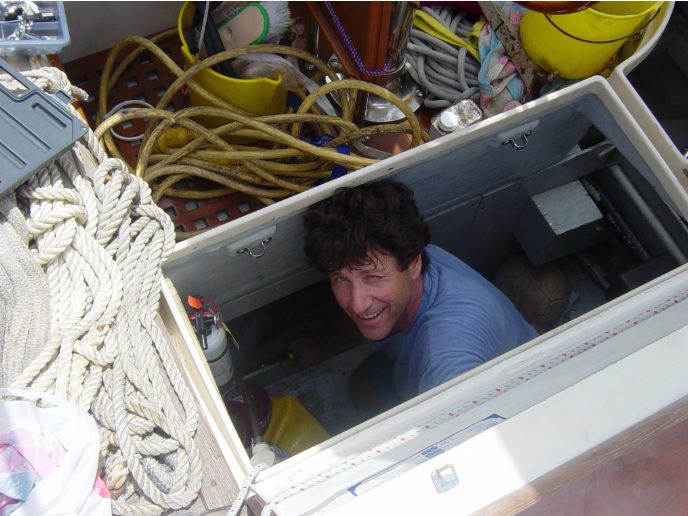Mecanica Gallardo
Friday, 2200hrs CST, April 9, 2004:
S 00o44.869′, W 090o18.517′
(Puerto Ayora, Galapagos Island)
Journal Entry continued …
With Kay and Matthew headed home, Peter exploring another island, and Dick and Suzie staying in a hotel on shore, Tuesday April 7, was to be engine maintenance day. As recommended by various sources, the engine oil and oil filters should be changed every 100 hours. As recommended by the mechanic, Scott, in Hinckley Yard in Stuart Florida, the fuel filters and water impeller should be changed with similar frequency. Lillian was about 30 hours overdue, but this was an operation that I approached with some hesitation. The engineer in me appreciates the need for scheduled maintenance but, not being a mechanic, I hate messing around with a smoothly operating engine. I was particularly hesitant, since I’d never worked on Lillian’s engine before but only watched as, 130 engine hours earlier, the mechanic at Hinckley removed parts, skinned knuckles, dropped tools into the bilge, and vehemently cursed the location of the various filters. It took him over half a day to do the job. I took notes. Now it was my turn.

The first part, changing the oil and oil filters, went very smoothly, partly because I had learned how to remove access panels that the Hinckley mechanic didn’t know about. The second part was also going well and I was beginning to feel quite proud of myself when the unthinkable happened. Suspended with my head down, leaning well into the aft engine compartment, I twisted the “T”-handle off the top of the primary filter and then watched in shock as it slipped from my hand and in two bounces perished into the thirteenth circle of the bilge. For those of you thinking, “why didn’t you retrieve it?” all I can say is you haven’t seen my bilge, an impenetrable slime pool located deep below the engine, with no room for access except for objects on the way down. I did try with a magnet for about an hour and then realized the futility. Nor could I easily pump out the bilge in the pristine environment of Puerto Ayora, and besides, that would not necessarily reveal the part. I repeatedly cursed my carelessness and wondered how long it would take to Fed-Ex a Racor “T”-handle to the Galapagos. The next solution seemed to be to find a replacement part on the island.
About this time Dick showed up via water taxi and tried to console me by saying that it was just part of the adventure. While it was no consolation at the time, he was right. That afternoon I was introduced to the locally renowned hardware store, Bodega Blanca, run by a spirited self-taught elderly gentleman and his son, Jason Gallardo. With feelings of salvation I noted marine parts hanging on the wall. With even more relief I learned that the elderly man spoke some English. With further surprise, I discovered that his son Jason’s english was pure Californian and that he had gone to high school in the small town of Cleveland Tennessee, which, with two Ecuadorians on the team, had dominated the local soccer championships. They didn’t have the part. But, Jason’s uncle owned a mechanics shop, Mecanica Gallardo, where purportedly they could fabricate anything. That afternoon, I removed the primary fuel filter from the fuel system and carried the parts to Mecanica Gallardo’s in a bright yellow bucket, thus distinguishing myself from the average tourist in town. The next day I returned with my empty bucket to retrieve the filter and its skillfully crafted new “T” handle. The part was made from a welded combination of
threaded rod and a triangular handle. The rod included a critical groove and o-ring needed to seal the filter top, and the triangular handle included a ¼ inch hole neatly drilled in the corner. While they did not speak English at Gallardo’s and thus couldn’t explain the significance of the hole, I assume it is for a safety line so that next time I try to drop the handle into the bilge it won’t get far. All is now back in place and the engine seems to be no worse for the experience and I now appreciate Dick’s comment.